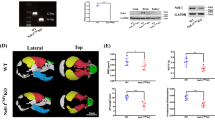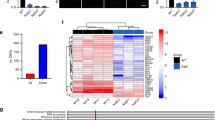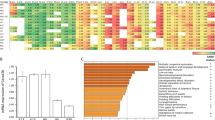Abstract
The protein EP300 and its paralog CREBBP (CREB-binding protein) are ubiquitously expressed transcriptional co-activators and histone acetyl transferases1. The gene EP300 is essential for normal cardiac and neural development, whereas CREBBP is essential for neurulation, hematopoietic differentiation, angiogenesis and skeletal and cardiac development2,3,4,5. Mutations in CREBBP cause Rubinstein-Taybi syndrome, which is characterized by mental retardation, skeletal abnormalities and congenital cardiac defects6,7. The CBP/p300-interacting transactivator with ED-rich tail 2 (CITED2) binds EP300 and CREBBP with high affinity8 and regulates gene transcription8,9,10. Here we show that Cited2−/− embryos die with cardiac malformations, adrenal agenesis, abnormal cranial ganglia and exencephaly. The cardiac defects include atrial and ventricular septal defects, overriding aorta, double-outlet right ventricle, persistent truncus arteriosus and right-sided aortic arches. We find increased apoptosis in the midbrain region and a marked reduction in ErbB3-expressing neural crest cells in mid-embryogenesis. We show that CITED2 interacts with and co-activates all isoforms of transcription factor AP-2 (TFAP2). Transactivation by TFAP2 isoforms is defective in Cited2−/− embryonic fibroblasts and is rescued by ectopically expressed CITED2. As certain Tfap2 isoforms are essential in neural crest, neural tube and cardiac development11,12,13, we propose that abnormal embryogenesis in mice lacking Cited2 results, at least in part, from its role as a Tfap2 co-activator.
This is a preview of subscription content, access via your institution
Access options
Subscribe to this journal
Receive 12 print issues and online access
$209.00 per year
only $17.42 per issue
Buy this article
- Purchase on Springer Link
- Instant access to full article PDF
Prices may be subject to local taxes which are calculated during checkout





Similar content being viewed by others
References
Goodman, R.H. & Smolik, S. CBP/p300 in cell growth, transformation, and development. Genes Dev. 14, 1553–1577 (2000).
Yao, T.P. et al. Gene dosage-dependent embryonic development and proliferation defects in mice lacking the transcriptional integrator p300. Cell 93, 361–72 (1998).
Oike, Y. et al. Mice homozygous for a truncated form of CREB-binding protein exhibit defects in hematopoiesis and vasculo-angiogenesis. Blood 93, 2771–2779 (1999).
Kung, A.L. et al. Gene dose-dependent control of hematopoiesis and hematologic tumor suppression by CBP. Genes Dev. 14, 272–277 (2000).
Oike, Y. et al. Truncated CBP protein leads to classical Rubinstein-Taybi syndrome phenotypes in mice: implications for a dominant-negative mechanism. Hum. Mol. Genet. 8, 387–396 (1999).
Petrij, F. et al. Rubinstein-Taybi syndrome caused by mutations in the transcriptional co-activator CBP. Nature 376, 348–351 (1995).
Stevens, C.A. & Bhakta, M.G. Cardiac abnormalities in the Rubinstein-Taybi syndrome. Am. J. Med. Genet. 59, 346–348 (1995).
Bhattacharya, S. et al. Functional role of p35srj, a novel p300/CBP binding protein, during transactivation by HIF-1. Genes Dev. 13, 64–75 (1999).
Shioda, T., Fenner, M.H. & Isselbacher, K.J. MSG1 and its related protein MRG1 share a transcription activating domain. Gene 204, 235–241 (1997).
Glenn, D.J. & Maurer, R.A. MRG1 binds to the LIM domain of Lhx2 and may function as a coactivator to stimulate glycoprotein hormone α-subunit gene expression. J. Biol. Chem. 274, 36159–36167 (1999).
Zhang, J. et al. Neural tube, skeletal and body wall defects in mice lacking transcription factor AP-2. Nature 381, 238–241 (1996).
Schorle, H., Meier, P., Buchert, M., Jaenisch, R. & Mitchell, P.J. Transcription factor AP-2 essential for cranial closure and craniofacial development. Nature 381, 235–238 (1996).
Satoda, M. et al. Mutations in TFAP2B cause Char syndrome, a familial form of patent ductus arteriosus. Nature Genet. 25, 42–46 (2000).
Haydar, T.F., Kuan, C.Y., Flavell, R.A. & Rakic, P. The role of cell death in regulating the size and shape of the mammalian forebrain. Cereb. Cortex 9, 621–626 (1999).
Le Douarin, N.M. & Kalcheim, C. The Neural Crest (Cambridge University Press, Cambridge, 1999).
Meyer, D. & Birchmeier, C. Multiple essential functions of neuregulin in development. Nature 378, 386–390 (1995).
Britsch, S. et al. The ErbB2 and ErbB3 receptors and their ligand, neuregulin-1, are essential for development of the sympathetic nervous system. Genes Dev. 12, 1825–1836 (1998).
Riethmacher, D. et al. Severe neuropathies in mice with targeted mutations in the ErbB3 receptor. Nature 389, 725–730 (1997).
Erickson, S.L. et al. ErbB3 is required for normal cerebellar and cardiac development: a comparison with ErbB2- and heregulin-deficient mice. Development 124, 4999–5011 (1997).
Juriloff, D.M. & Harris, M.J. Mouse models for neural tube closure defects. Hum. Mol. Genet. 9, 993–1000 (2000).
Dunwoodie, S.L., Rodriguez, T.A. & Beddington, R.S.P. Msg1 and Mrg1, founding members of a gene family, show distinct patterns of gene expression during mouse embryogenesis. Mech. Dev. 72, 27–40 (1998).
Mitchell, P.J., Timmons, P.M., Hebert, J.M., Rigby, P.W. & Tjian, R. Transcription factor AP-2 is expressed in neural crest cell lineages during mouse embryogenesis. Genes Dev. 5, 105–119 (1991).
Moser, M., Ruschoff, J. & Buettner, R. Comparative analysis of AP-2α and AP-2β gene expression during murine embryogenesis. Dev. Dyn. 208, 115–124 (1997).
Skinner, A. & Hurst, H.C. Transcriptional regulation of the c-erbB-3 gene in human breast carcinoma cell lines. Oncogene 8, 3393–3401 (1993).
Tybulewicz, V.L., Crawford, C.E., Jackson, P.K., Bronson, R.T. & Mulligan, R.C. Neonatal lethality and lymphopenia in mice with a homozygous disruption of the c-abl proto-oncogene. Cell 65, 1153–1163 (1991).
Herrera, E., Samper, E. & Blasco, M.A. Telomere shortening in mTR−/− embryos is associated with failure to close the neural tube. EMBO J. 18, 1172–1181 (1999).
Wilkinson, D.G. Whole mount in situ hybridization of vertebrate embryos. in In Situ Hybridization (ed. Wilkinson, D.G.) 75–83 (IRL, Oxford, 1992).
Bosher, J.M., Totty, N.F., Hsuan, J.J., Williams, T. & Hurst, H.C. A family of AP-2 proteins regulates c-erbB-2 expression in mammary carcinoma. Oncogene 13, 1701–1707 (1996).
Loo, D., Rawson, C., Ernst, T., Shirahata, S. & Barnes, D. Primary and multipassage culture of mouse embryo cells in serum-containing and serum-free media. in Cell Growth and Division: A Practical Approach (ed. Baserga, R.) 17–35 (Oxford University Press, Oxford, 1989).
Ausubel, F. et al. Short Protocols in Molecular Biology 4th ed (John Wiley & Sons, New York, 1995).
Acknowledgements
We are grateful to R. Gardner and F. Brook for advice and to all those who generously gave us reagents. We thank R. Sumner, J. Corrigan, T. Swingler and C. Ibbitt for excellent technical help. J.J.E. and H.C.H. are supported by the Imperial Cancer Research Fund, J.N.M. by the Medical Research Council and H.F. and D.J.H. by the British Heart Foundation. These studies were funded by a Wellcome Senior Research Fellowship in Clinical Science award to S.B.
Author information
Authors and Affiliations
Corresponding author
Rights and permissions
About this article
Cite this article
Bamforth, S., Bragança, J., Eloranta, J. et al. Cardiac malformations, adrenal agenesis, neural crest defects and exencephaly in mice lacking Cited2, a new Tfap2 co-activator. Nat Genet 29, 469–474 (2001). https://doi.org/10.1038/ng768
Received:
Accepted:
Published:
Issue Date:
DOI: https://doi.org/10.1038/ng768
This article is cited by
-
Dysregulation of CITED2 in abnormal lung development in the nitrofen rat model
Pediatric Surgery International (2024)
-
Development and function of the fetal adrenal
Reviews in Endocrine and Metabolic Disorders (2023)
-
The role of DNA methylation in syndromic and non-syndromic congenital heart disease
Clinical Epigenetics (2021)
-
Msx1 haploinsufficiency modifies the Pax9-deficient cardiovascular phenotype
BMC Developmental Biology (2021)
-
Prediction of enhancer–promoter interactions using the cross-cell type information and domain adversarial neural network
BMC Bioinformatics (2020)



